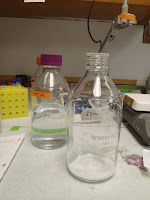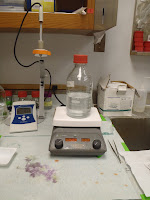Congratulations are in order for Ms. Qiying Fan, the hard-working and dedicated Ph.D. graduate student, who successfully completed her graduate research proposal this week. The entire research team is so proud of her and we couldn't have asked for a more positive response from the committee.
 |
| Congrats to Fan! |
The entire research team and our PI have been pretty busy-writing grants and conducting/planning experiments.
 |
| Tony Ohonba-Pharmacy Student |
 |
| My Graduate Student Mentor and I |
Andrea has been planning experiments and the next steps for her project which is likely to span months. During the previous weeks, she had been refining her skills at inducing myocardial infarctions on her live specimen (mice). Now, with her technique finalized, she is officially ready to begin the actual experimental part of the project. She will be injecting certain stem cells into her specimen to test whether these cells improve cardiac function after the infarction. Her overreaching goal is to figure out if these stems cells aid in the recovery of localized damaged tissue in the heart.
Abeer has been continuing her experiments involving cardiomyocyte isolations. Once she obtains the cardiomyocytes (the cells that comprise cardiac muscle), she performs measurements to figure out the calcium ratio present using a specialized miscroscope called the Ionoptix. The calcium ratio will determine the degree of contractility in the cardiomyocytes.
Fan, while still recovering from a stressful week, has been continuing the development of Western blots to detect different treatments of Bapta-AM, a calcium inhibitor (used because calcium is involved in the specific pathway she is trying to identify). She has been treating VSMC (vascular smooth muscle cells) to see how specific growth factors affect VSMC intracellular signaling. Overall, this will further her understanding of how calcium, and how much with her different experimental groups, is involved in the pathway.
I had to opportunity to make my own Western Blot Stripping Buffer using substrates from the lab. A stripping buffer is used in Western blots before the blocking stage to remove primary and secondary antibodies from the PVDF membrane and allow chemiluminescent Western blots to be reprobed. This saves time and is more efficient than continuously performing gel electrophoresis and duplicate immunoblot assays. In other words, it allows the experimenter to reuse a PVDF blot to detect a different target with a different primary antibody.
 |
| Effect of Stripping Buffer on Membranes |
 |
| Mild Stripping Buffer-Protocol |
 |
| Glycine-15 g |
 |
| SDS-1 g |
 |
| Tween 20-10 mL |
 |
| Adjusting the pH to an Acidic Level |
 |
| Adjusting pH |
 |
| The Finished Product |
 |
| Aluminum Foil used to Protect Against Light Sensitivity |
 |
| Commercial Stripping Buffer |
So, instead of spending $134 to buy a commercial buffer, why not recreate it on your own? :)
Other activities this week included preparing transfer buffer, running buffer, developing Western blots, transferring tissue to histology cassettes, and autoclaving.



























































